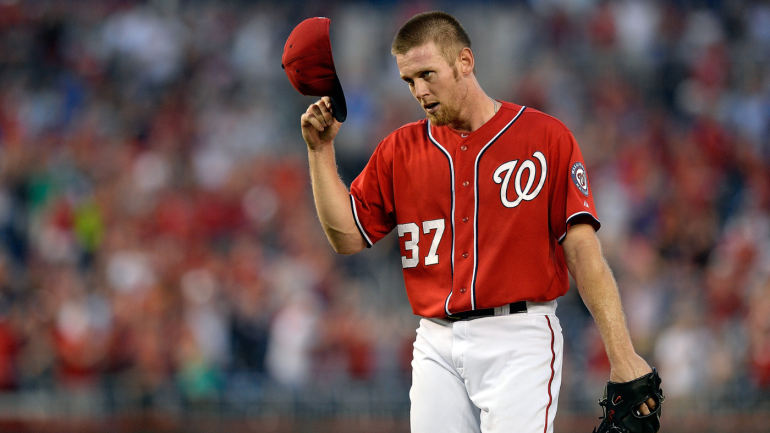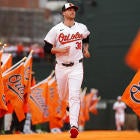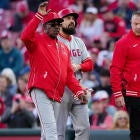
News broke Thursday that Nationals starting pitcher Stephen Strasburg is going to retire sometime here in the next few weeks. It isn't all too surprising to consider that we won't see Strasburg pitch again because he'd just had so many issues here the last few years, including surgery for thoracic outlet syndrome twice.
It's a relatively rare career for a player to actually leave a legacy, which is to say, in sports terms, a lasting memory on the game at large. Strasburg truly did and it's one that I imagine will eventually see his No. 37 retired by the Nationals. It was quite a roller coaster, too, with the peaks of his insane ability along with the valleys that were the unfortunate injuries. Let's take a ride on this coaster.
The phenom
Strasburg wasn't even drafted out of high school. His sophomore year at San Diego State is when he really took off. He made 13 starts after serving only in relief (with seven saves!) as a freshman. In those 13 starts, he had a 1.58 ERA with 133 strikeouts against 16 walks in 97 1/3 innings. Heading into 2009, he was already getting traction as a No. 1 pick before going 13-1 in 15 starts with a 1.32 ERA and 195 strikeouts against 19 walks in 109 innings.
He was scooped up by agent Scott Boras and it was a foregone conclusion that the Nats would draft him first overall. They did.
Strasburg only made five starts in the Arizona Fall League, but then it was full go on the hype train next spring. He was named by some outlets the top prospect in all of baseball (Baseball America had him second behind Jason Heyward). In five starts for Double-A Harrisburg, he dominated. In six starts for Triple-A Syracuse, he was even better (1.08 ERA).
It was time for Strasmas.
Strasmas and TJ
Yes, when Strasburg first hit the majors for the Nationals, it was considered such a baseball holiday that his last name and Christmas were made into a portmanteau. His gift became the gift of the baseball world, as he was living up to the absurdly high expectations.
Just watch the highlights from his debut. Keep in mind the Nationals were coming off back-to-back 100-plus loss seasons and were in last place during this game.
He struck out 14 without walking anyone. What an incredible debut. He would finish the season with a 2.91 ERA (139 ERA+) and 92 strikeouts in 68 innings. He also dealt with a shoulder injury and then an elbow injury that required Tommy John surgery.
He returned from the surgery late in 2011 to make five starts and was outstanding. He had a 1.50 ERA with 24 strikeouts and only two walks in 24 innings.
That paved the way for 2012.
The shutdown
The 2012 Nats broke through. After years of futility, they started furiously and were sitting 14-4 through late April. The way everything timed out ended up creating a ton of controversy, as the Nationals had a self-imposed innings limit on Strasburg due to the Tommy John surgery. But they were also contending and ended up winning 98 games that season while Strasburg was pitching like an ace.
After a start on Sept. 8, the Nationals revealed that Strasburg was shut down for the season. The Nationals were bounced from the NLDS by the Cardinals, three games to two.
Prime as a frontline starter
If the main goal of the shutdown was to protect the investment of Strasburg in the long term instead of salivating over a short-term opportunity, Nationals general manager Mike Rizzo probably had the last laugh here. From 2013-19, Strasburg was one of the more valuable starting pitchers in baseball. He had some nagging issues and bouts of inconsistency, but he never made fewer than 22 starts in a season and averaged 28 a year. In those 194 starts, he went 91-48 with a 3.21 ERA, 1.09 WHIP and 1,382 strikeouts in 1,187 2/3 innings. He got Cy Young votes three different seasons and finished in the top five twice.
It wasn't an other-worldly stretch or anything, but he was a frontline starter for nearly a decade. There aren't many pitchers who pull that off. Just to give some context behind it, Strasburg's age-30 season was 2019. The most statistically similar pitchers to Strasburg through age 30 are Gerrit Cole, Jered Weaver, Max Scherzer, David Price and Roy Oswalt.
And, obviously, 2019 was a special year in D.C.
The World Series champion and MVP
After years of playoff failures, the Nationals finally went all the way in 2019 and won it all with a group that included so many players who had been through years of playoff disappointments.
That team won fewer games than the Nationals teams in 2012, 2014, 2016 and 2017 and nearly lost the Wild Card game. It started 19-31 and then got hot. It leaned heavily on Strasburg, Scherzer and, to a lesser extent, Patrick Corbin in the playoffs on the mound. Strasburg threw three scoreless innings in relief in the Wild Card game and grabbed the win. He went 4-0 in five starts in the NLDS, NLCS and World Series combined. He ended up 5-0 with a 1.98 ERA that postseason, striking out 47 while only walking four in 36 1/3 innings. He won the World Series MVP and if there were such a thing, would've taken the MVP of the entire playoffs.
That alone cemented Strasburg's legacy forever in D.C.
Overall, in nine career postseason appearances, Strasburg was 6-2 with a 1.46 ERA, 0.94 WHIP and 71 strikeouts in 55 1/3 innings. He was the first pitcher ever to go 5-0 in a single postseason. His playoff ERA ranks fifth all-time among pitchers with least 50 innings, behind Mariano Rivera, Sandy Koufax, Christy Mathewson and Eddie Plank.
Injuries prevented Hall of Fame case
We don't really need to hash out how badly everything has gone since 2019, right? It's not Strasburg's fault. His arm is just cooked.
When such a big name retires, I usually run through a quick Hall of Fame case, but he's just not there. That incredible postseason resume provides a boost, sure, but he needed more than just a boost. He finishes 113-62 with a 3.24 ERA and 1.10 WHIP. He struck out 1,723 in his 1,470 innings. You could argue he pitched on a Hall of Fame level on a rate basis (ERA, WHIP, K/9, K%, K/BB, etc.), but he didn't have the longevity and that's where he was robbed.
To that point, Strasburg was a strikeout artist, but didn't get to 2,000 strikeouts. The threshold for starter wins will likely go way down in the near future, but 113 is still very low. The only Hall of Fame starting pitchers with fewer than 1,800 innings pitched are special cases, such as Satchel Paige or Bullet Rogan. Strasburg sits 250th in JAWS among starting pitchers and the Hall of Fame is far more exclusive than that.
The bottom line here is the easiest way to sum up the career of Stephen Strasburg is the intersection of greatness and injury issues. He was truly a Hall of Fame talent. He lived up to said talent when he was on the mound. He just wasn't on the mound enough to get to the Hall of Fame.
Still, there were enough peaks that it's a career worth celebrating. The Nationals very likely will do so by retiring his number sometime in the near future. He deserves it.






















